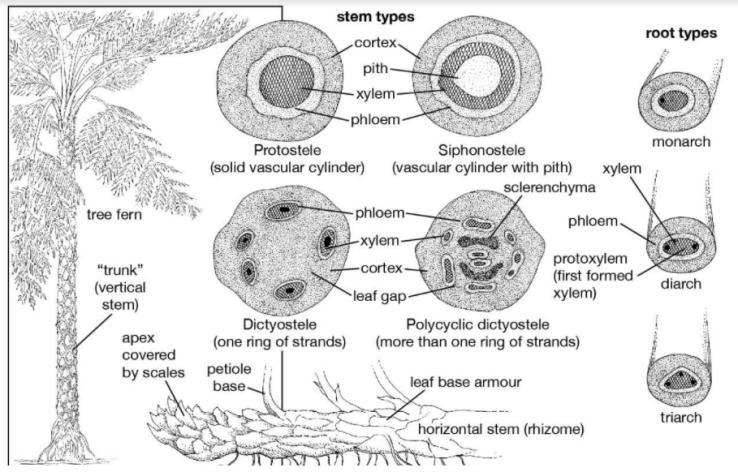
What is polycyclic steel?
Answer
375.9k+ views
Hint: One should be having at first a clear idea about what is called a stele. A stele is actually the association of central vascular cylindrical bundles (composed of xylem and phloem) along with the endodermis layer of the cortex. The stele was discovered by two scientists Van Tieghem and Douliot in the year 1886. The term stele actually means ‘pillar’.
Complete answer:
Steles are of 5 types. They are listed below:
1. Protostele
a. Haplostele
b. Actinostele
c. Plectostele
d. Mixed-pith stele
2. Siphonostele
a. Ectophloic
b. Amphiphloic
3. Solenostele
4. Dictyostele
5. Polycyclic stele
6. Eustele
Among all these types, we may have a look at the polycyclic stele.
A polycyclic stele is the most complex of all the steles. This type is basically siphonostelic in structure. A typical polycyclic stele consists of two or more concentric rings of vascular tissues. Each such stele actually consists of an internal vascular system connected with an outer siphonostele.
Sometimes, the structure may also be solenostelic or dictyostelic, which are themselves derived from siphonostele.

Note:
As discussed above, a polycyclic stele basically consists of two or more concentric vascular bundle rings which are siphonostelic or solenostelic or dictyostelic in structure.
Solenostelic and dictyostelic are also derived from siphonosteles.
So, it would be useful for us to learn the basic structure of siphonostele.
A stele in which the protostele is medullated is known as siphonostele. Such steles contain a tubular vascular region and a parenchymatous central region.
Complete answer:
Steles are of 5 types. They are listed below:
1. Protostele
a. Haplostele
b. Actinostele
c. Plectostele
d. Mixed-pith stele
2. Siphonostele
a. Ectophloic
b. Amphiphloic
3. Solenostele
4. Dictyostele
5. Polycyclic stele
6. Eustele
Among all these types, we may have a look at the polycyclic stele.
A polycyclic stele is the most complex of all the steles. This type is basically siphonostelic in structure. A typical polycyclic stele consists of two or more concentric rings of vascular tissues. Each such stele actually consists of an internal vascular system connected with an outer siphonostele.
Sometimes, the structure may also be solenostelic or dictyostelic, which are themselves derived from siphonostele.

Note:
As discussed above, a polycyclic stele basically consists of two or more concentric vascular bundle rings which are siphonostelic or solenostelic or dictyostelic in structure.
Solenostelic and dictyostelic are also derived from siphonosteles.
So, it would be useful for us to learn the basic structure of siphonostele.
A stele in which the protostele is medullated is known as siphonostele. Such steles contain a tubular vascular region and a parenchymatous central region.
Recently Updated Pages
Difference Between Prokaryotic Cells and Eukaryotic Cells

Master Class 12 Business Studies: Engaging Questions & Answers for Success

Master Class 12 English: Engaging Questions & Answers for Success

Master Class 12 Economics: Engaging Questions & Answers for Success

Master Class 12 Chemistry: Engaging Questions & Answers for Success

Master Class 12 Social Science: Engaging Questions & Answers for Success

Trending doubts
One Metric ton is equal to kg A 10000 B 1000 C 100 class 11 physics CBSE

Pigmented layer in the eye is called as a Cornea b class 11 biology CBSE

The lightest gas is A nitrogen B helium C oxygen D class 11 chemistry CBSE

What is spore formation class 11 biology CBSE

In the tincture of iodine which is solute and solv class 11 chemistry CBSE

What are the limitations of Rutherfords model of an class 11 chemistry CBSE




